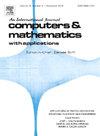基于四场公式的热孔弹性有效迭代解耦方法
IF 2.5
2区 数学
Q1 MATHEMATICS, APPLIED
引用次数: 0
摘要
本文研究了热孔弹性模型。通过引入中间变量,将原来的三场模型转化为四场模型。在此四场模型的基础上,提出了耦合有限元法和解耦迭代有限元法。证明了耦合有限元法的稳定性和最优收敛性。进一步证明了解耦迭代法的收敛性。本文主要分析了迭代解耦算法。结果表明,该算法的收敛性不需要对物理参数或稳定参数作任何额外的假设。数值结果证明了这些新方法的有效性和理论有效性。本文章由计算机程序翻译,如有差异,请以英文原文为准。
An efficient iterative decoupling method for thermo-poroelasticity based on a four-field formulation
This paper studies the thermo-poroelasticity model. By introducing an intermediate variable, we transform the original three-field model into a four-field model. Building upon this four-field model, we present both a coupled finite element method and a decoupled iterative finite element method. We prove the stability and optimal convergence of the coupled finite element method. Furthermore, we establish the convergence of the decoupled iterative method. This paper focuses primarily on analyzing the iterative decoupled algorithm. It demonstrates that the algorithm's convergence does not require any additional assumptions about physical parameters or stabilization parameters. Numerical results are provided to demonstrate the effectiveness and theoretical validity of these new methods.
求助全文
通过发布文献求助,成功后即可免费获取论文全文。
去求助
来源期刊

Computers & Mathematics with Applications
工程技术-计算机:跨学科应用
CiteScore
5.10
自引率
10.30%
发文量
396
审稿时长
9.9 weeks
期刊介绍:
Computers & Mathematics with Applications provides a medium of exchange for those engaged in fields contributing to building successful simulations for science and engineering using Partial Differential Equations (PDEs).
 求助内容:
求助内容: 应助结果提醒方式:
应助结果提醒方式:


